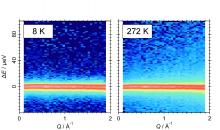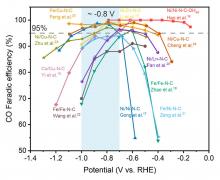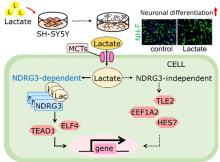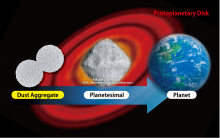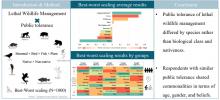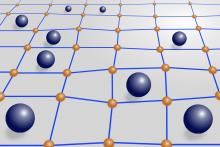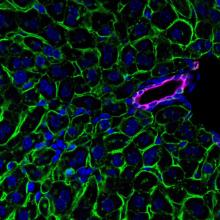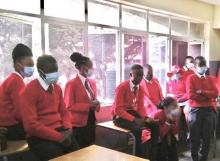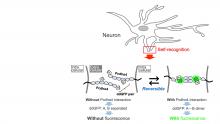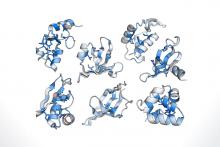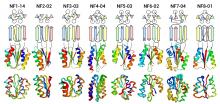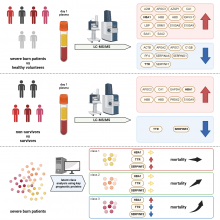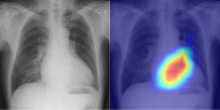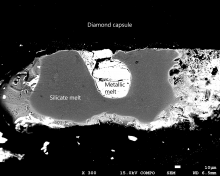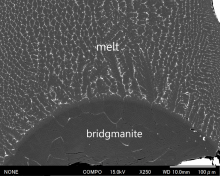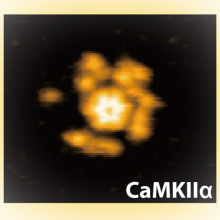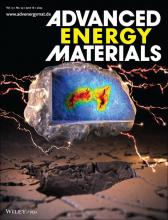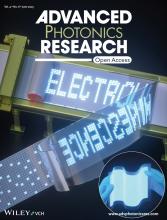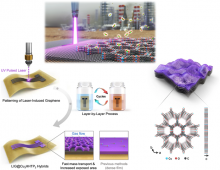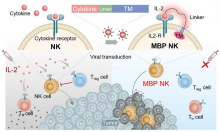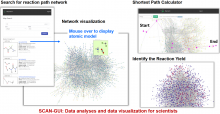Peer Reviewed
News
26 Jul 2023
Researchers from Osaka University use quasi-elastic neutron scattering to get a close look at the behavior of water molecules in a semiclathrate hydrate crystal. They found that the molecules showed fast reorientation with an activation energy similar to that of cleaving a hydrogen bound. This rapid relaxation time in the solid electrolyte is expected to lead to efficient, cost-effective, and safe applications for semiclathrate hydrates in batteries and thermal storage materials.
26 Jul 2023
Researchers at Tohoku University have unraveled the reasons behind the underperformance of a promising field of catalysis known as dual atom catalysts (DACs). Their findings shed light on the challenges faced by DACs in converting carbon dioxide into valuable multicarbon products.
24 Jul 2023
Lactate is a byproduct of exercise and metabolism, fueling our brain when oxygen is limited. More recently, scientists have become aware of the many roles it plays in developing our nervous system. Now, researchers from Tohoku University have unearthed the cellular mechanisms by which lactate helps our brains develop.
21 Jul 2023
An exquisitely preserved fossil forest from Japan provides missing links and helps reconstruct a whole Eurasia plant from the late Miocene epoch.
21 Jul 2023
Current evidence suggests that microparticles of cosmic dust collide and stick together to form larger dust aggregates that may eventually combine and develop into planets. Numerical models that accurately characterize the conditions required for colliding microparticle aggregates to stick together, rather than bounce apart, are therefore paramount to understanding the evolution of planets. Recent modeling suggests that dust aggregates are less likely to stick together after a collision as the size of the aggregates increases.
20 Jul 2023
Japan’s population may be on the decline, but it is the opposite for many wildlife species. This has increased the number of human-wildlife interactions. Controversially, lethal management is sometimes employed to manage this issue. But a holistic understanding of the public’s attitude to this approach has been lacking. Now, researchers have surveyed the public’s opinion on the topic, hoping to provide data that can direct future management practices.
20 Jul 2023
Researchers from the Institute of Industrial Science, The University of Tokyo, provide physical insights into porous soft materials, which will facilitate the design of many energy, medical, and other technologies.
19 Jul 2023
Scientists have combined two light wavelengths to deactivate a bacterium that is invulnerable to some of the world’s most widely used antibiotics, giving hope that the regime could be adapted as a potential disinfectant treatment.
19 Jul 2023
Omega-3 lysolipids are important for protecting the liver from dietary fat, according to Duke-NUS researchers and collaborators from SGH.
19 Jul 2023
A joint research group at Osaka Metropolitan University conducted a survey on prevalence of obesity and factors associated with low obesity among 423 adolescents between the ages of 14 and 19 living in Harare, Zimbabwe. The results revealed that 15.8% were obese or overweight. The study also revealed that 27.1% of the participants had low obesity awareness, which was significantly related to parents/guardians' lack of formal education and insufficient knowledge about eating habits.
18 Jul 2023
RNases have been proposed as a treatment against systemic autoimmune diseases. Researchers from Osaka University showed that RNases have a dual action. In some cases, RNases are detrimental and stimulate the immune response by promoting the binding of antibodies to their targets. These findings will improve the understanding and treatment of systemic autoimmune disorders.
14 Jul 2023
Researchers from Osaka University have developed a fluorescent sensor that may be useful for understanding how cells recognize themselves versus other cells when making connections in the brain. Specifically, their sensor can be used to visualize not only connections between cells, but also the disassociation of these interactions. Because neuronal self-connectivity has been implicated in brain disorders like epilepsy and autism, a better understanding of this process may result in improved therapies.
14 Jul 2023
Researchers from Northwestern University and recently joining the Institute for Industrial Science, The University of Tokyo develop a high-throughput approach to evaluate protein folding stability in thousands of proteins .
11 Jul 2023
A research team has discovered an astounding array of unexplored protein folds. This research will expand our understanding of the depth of the protein universe and the possibilities for de novo design of functional proteins.
11 Jul 2023
The physiological mechanisms underlying severe burns are not well understood. Researchers at Osaka University used mass spectrometry to identify key blood proteins associated with burn mortality. Ultimately, three proteins (HBA1, TTR, SERPINF2) were very highly correlated with morality rates. Further research into these proteins and their pathways may lead to better drugs to treat people with life-threatening burns.
11 Jul 2023
The entire biosynthetic pathway of actinopyridazone has been unveiled, revealing that an unprecedented carrier protein-mediated ring-forming step is key to its synthesis.
06 Jul 2023
Osaka Metropolitan University scientists have successfully developed a model that utilizes AI to accurately classify cardiac functions and valvular heart diseases from chest radiographs. The Area Under the Curve, or AUC, of the AI classification showed a high level of accuracy, exceeding 0.85 for almost all indicators and reaching 0.92 for detecting left ventricular ejection fraction—an important measure for monitoring cardiac function.
06 Jul 2023
The composition of the Earth’s earliest atmosphere
06 Jul 2023
How have the atmosphere and mantle oxidation state of the Earth changed?
05 Jul 2023
Researchers at Kanazawa University report in Science Advances high-speed atomic force microscopy experiments that show the structural and chemical changes in an enzyme thought to play a vital role in modulating the strength of neural connections.
04 Jul 2023
- DGIST-Chungnam National University Team Creates Real-Time Digital Twin Multiphysics Model for Predicting Electrochemical and Mechanical Properties of Micro-Particles for the First Time
- Cover Paper Recognition: Chosen by Prominent Journal Advanced Energy Materials
04 Jul 2023
- A research team led by Dr. Byeong-dae Choi at the Division of Electronics & Information System, DGIST, greatly improved the efficiency of electroluminescent devices by applying silver nanofilms.
- This opens up the possibility of developing affordable digital film signage.
04 Jul 2023
- A research team led by Professor Hyuk-jun Kwon, a DGIST Professor, successfully developed a graphene-metal organic framework hybrid structure with hierarchical porosity
- A technology capable of detecting extremely low concentrations of nitrogen dioxide at the level of one billionth in real-time... Expected to be applied to next-generation healthcare devices
04 Jul 2023
- Joint research team of DGIST Professor JeongHo Kwak and KAIST Professor Jihwan Choi develops a network slicing planning and handover technique for next-generation 6G low LEO satellite networks
- This work is expected to contribute to various services using satellite networks in the era of 6G satellite networks in the future such as Starlink and OneWeb
04 Jul 2023
A new method for connecting neurons in neuromorphic wetware has been developed by researchers from Osaka University and Hokkaido University. The wetware comprises conductive polymer wires grown in a three-dimensional configuration, done by applying square-wave voltage to electrodes submerged in a precursor solution. The voltage can modify wire conductance, allowing the network to be trained. This fabricated network is able to perform unsupervised Hebbian learning and spike-based learning.
04 Jul 2023
- Principal Researcher Jinhyo Yun’s team at the DGIST publishes a comparative study on South Korea and Italy using the commons as a business model in one of the top international journals
- This work opens new prospects in sustainable capitalism
04 Jul 2023
- Professor Minseok Kim’s team at the DGIST confirmed the excellent anticancer effects of the NK cell therapy product that can self-activate in preclinical trials with CT Cells
- This work is expected to be applied in various fields as a next-generation anticancer therapy using NK cells
04 Jul 2023
DGIST (academia), Samsung C&T Corporation (industry), and MFR (research) entered into an MOU to conduct joint research on high-tech construction automation
04 Jul 2023
DGIST published a comparative study of the smart payment industry in Korea, China, and the UK in a top international journal
03 Jul 2023
A new online platform to explore computationally calculated chemical reaction pathways has been released, allowing for in-depth understanding and design of chemical reactions.
Events
Sorry, no events coming up for this topic.
Researchers
Sorry, no researchers coming up for this topic.
Giants in history
Sorry, no researchers coming up for this topic.


